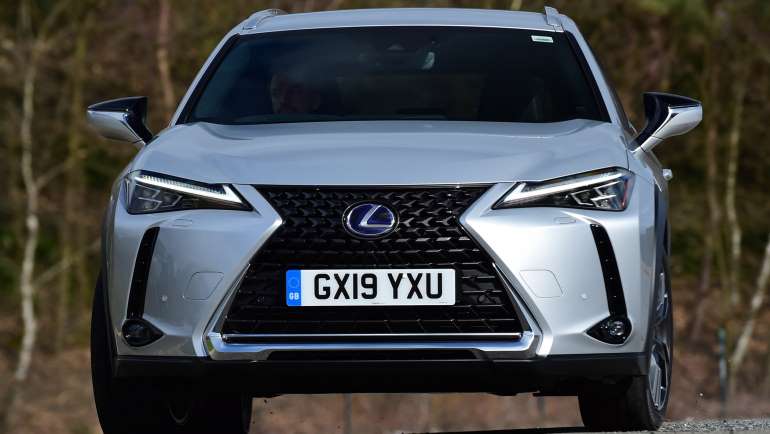"The economical Lexus UX looks and feels great, but falls short on versatility"
The premium compact SUV class is growing rapidly at the moment. Buyers can't get enough of fashionable crossovers such as the BMW X2 and Audi Q2. 'Hybrid' has become something of a buzzword, too, so a hybrid premium compact SUV really ought to be a sales sensation.
This is what Lexus, the upmarket arm of Toyota, hopes for its all-new UX 250h. It's the smallest SUV the company has yet offered, slotting beneath the Lexus NX in the brand's line-up and offering an alternative to its other hybrid model, the more conventionally styled Lexus CT hatchback. It'll also compete against the Jaguar E-Pace and Volvo XC40, while potentially persuading would-be Toyota C-HR buyers to push a little further upmarket.
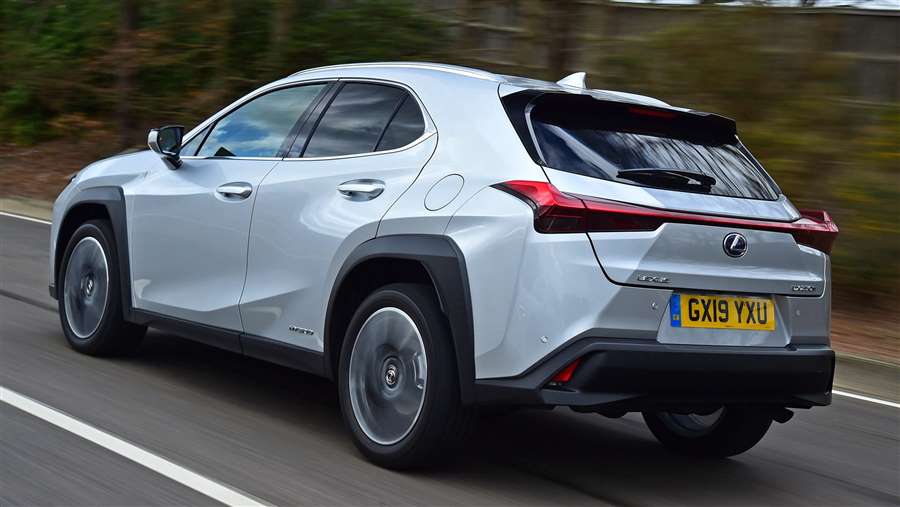
It comes as no surprise that Lexus should opt for hybrid power in its smallest SUV – the larger Lexus RX was something of a pioneer, offering hybrid power since 2004. The technology has since made big leaps forward in fuel-efficiency, though, and Lexus claims some fairly startling economy figures for the smaller, lighter UX. Modest CO2 emissions figures should make the UX an attractive proposition for company-car users, too.
Externally, the Lexus UX wears the brand's trademark 'spindle' grille, but isn't quite as bold and outspoken as the larger Lexus NX. The overall shape has the sleek silhouette of the latest coupe-SUVs, and despite its tough-looking black wheelarch mouldings, the stance is more soft-roader than go-anywhere vehicle.
That streamlined shape is reflected inside, where interior headroom is more saloon than SUV and the driving position is only a little higher than a typical family hatchback. Boot space is rather meagre, too, so this might be a crossover more suitable for couples than larger parties.
Although some may miss the lofty perch that other SUVs can provide, many will enjoy the UX's sporty driving position; there's no doubt it contributes to the driving experience, which feels a little more involving than some rivals. It just goes to show how capable Toyota's TNGA platform – also found under the Toyota Prius hybrid and latest Toyota Corolla – really is. Four-wheel drive is also offered in the UX 250h hybrid, badged E-Four, but we wouldn't recommend this version unless you really need extra traction in winter, because it makes the car less efficient.
Touted as a cutting-edge product at launch, the UX ticks all the usual safety boxes with autonomous emergency braking, lane-departure warning, traffic-sign recognition and automatic headlights. There's a radar cruise-control system, too, with a mode for use in stop-start traffic at up to 18mph.
Lexus proudly occupies the number-one slot in our 2020 Driver Power owner satisfaction survey, even though the brand's three-year/60,000-mile warranty is less generous than Toyota's.
If you'd rather a longer warranty, the Toyota C-HR hybrid remains a less expensive – and slightly more spacious – alternative to the Lexus UX, but many will find the latter's extra style and interior appeal worth the extra outlay. High-mileage private buyers may find conventional diesel-powered rivals, such as the BMW X1 sDrive18d, will be cheaper to run, too.
Lexus UX MPG & CO2
The Lexus UX 250h uses the very latest hybrid technology that Toyota has to offer, having much in common with the latest Toyota Prius. Official WLTP figures span from 50.4 to 53.2mpg for the standard UX and 47mpg for the four-wheel drive version. We managed 50mpg in a test car, despite the big 18-inch alloy wheels included with the F-Sport trim level.
Stick with two-wheel drive and the Lexus UX emits from 120g/km of CO2 with 17-inch wheels fitted and 126g/km with 18-inch alloys. Benefit-in-Kind (BiK) liability for company-car drivers spans from 27 to 28%. Emitting around 135g/km, the four-wheel drive UX sits in a higher BiK band with either size wheels.
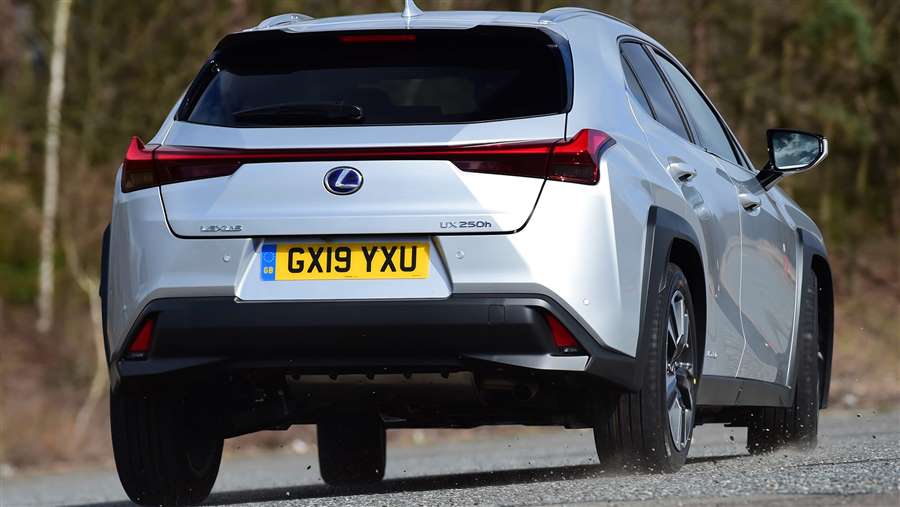
Insurance
The Association of British Insurers has placed the Lexus UX in insurance groups 22 to 26 out of 50, making the Lexus a little more expensive to insure than the cheaper but mechanically related Toyota C-HR hybrid, which occupies insurance group 14 in top-spec Excel form. Meanwhile, the most economical Mercedes GLA is in insurance group 21, while the BMW X1 starts in insurance group 26.
Servicing
Lexus offers fixed-price servicing for all models. Although pricing for the UX has yet to be announced, service schedules are sure to match the pattern of other hybrid models in the range, with a major service every 20,000 miles and an intermediate oil-change service every 10,000 miles.
Warranty
Lexus' three-year/60,000 mile warranty closely matches that provided by Volkswagen and Audi, but falls behind the three-year/unlimited-mileage warranties of Mercedes and BMW. It also lags behind that provided by Toyota, which lasts for five years or 100,000 miles. Lexus can provide an extended warranty, though, keeping you covered once your original policy's age or mileage limit is breached. It's also worth noting that the hybrid powertrain comes with a five-year/60,000 mile warranty for extra peace of mind.
The Lexus UX 250h uses a platform known as Toyota New Generation Architecture (TNGA), which underpins a range of cars as diverse as the Toyota Prius, Toyota Corolla and Toyota C-HR. That fact might not scream 'sporty', but prospective Lexus UX purchasers are in for a pleasant surprise.
Sitting in a driving position somewhat lower than that of most compact SUVs, you're well placed to get the most out of how the Lexus handles. That's no empty gesture, either, because the UX really does offer enough driving involvement to be a pleasure to drive. The steering is accurate and has a pleasingly weighty feel, while strong grip helps confidence in sharp corners.
Lexus claims to have gone to some lengths to make the UX feel good to drive, taking the trouble to mount the steering rack directly to the chassis in an effort to reduce flex and vibration, and these efforts have definitely paid off; the UX is more fun to drive than the Audi Q2 and runs the BMW X2 close. What's more, the car's impressive resistance to lean in corners doesn't come at the expense of a hard ride, at least not with the optional adaptive damping system fitted. We've yet to evaluate how the standard suspension deals with road imperfections.
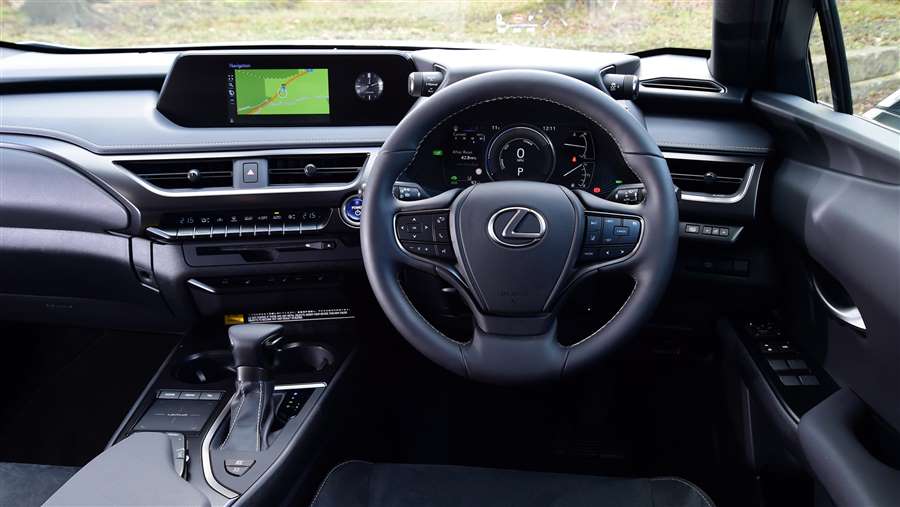
The UX is available with either front-wheel drive or 'E-Four' all-wheel drive, but the latter is intended more to maximise traction on poor roads and in adverse weather conditions than to bestow the UX with real all-terrain ability. For most buyers, we'd recommend saving the £1,200 or putting it towards a set of winter tyres for the front-wheel drive version.
Lexus UX hybrid engine
Only one engine is offered for the Lexus UX – the 250h. It's billed as a 'self-charging' hybrid, but that tag is little more than a positive spin on the fact that it has no plug-in facility. As a result, the UX can only move under all-electric power at moderate speeds, but it does bring a welcome degree of quietness in urban traffic.
The four-cylinder 2.0-litre petrol engine produces 144bhp and twin electric motors contribute 108bhp, making 0-62mph possible in 8.5 seconds. It feels quicker off the mark than the Audi Q2 fitted with a 1.5-litre turbo and driving is effortless thanks to a CVT automatic gearbox that proves smooth and seamless in operation. Unusually, the paddles either side of the steering wheel aren't for changing gear, but for setting the rate of regenerative braking. This system uses energy released during deceleration to help charge the UX's hybrid battery.
The E-Four four-wheel drive version gets an extra motor for the rear wheels, providing up to 7bhp and 55Nm of pulling power but also adding 60kg of weight. In most driving situations it feels identical to the front-wheel drive version, with enough electric assistance to prevent the petrol engine from feeling overworked. However, with less weight, the standard UX can run in EV mode more often, so unless you park on a slippery field or track every day, the benefits are marginal.
Interior & comfort
The Lexus UX looks and feels great inside
The Lexus UX is generally smooth and relaxing to travel in. At higher cruising speeds, its slippery shape helps to keep wind noise at bay, and occupants will find tyre noise far more intrusive than any other mechanical sound. The clever (optional) active damping system is effective at ironing out road bumps, but we've yet to try the standard suspension.
Lexus has established an enviable reputation for interior design and quality, and the UX doesn't disappoint. The materials used are from the top drawer, and the layout is distinctive and pleasing to look at. Enthusiasts might even spot a few visual influences from the range-topping Lexus LC sports coupe.
Lexus UX dashboard
The UX's dashboard sweeps around the driver, who's placed right in the centre of the action. The instrument cluster is a little smaller than that of some rivals, but its seven-inch digital display is clear and easy to understand and can be configured to your taste.
Lexus UX interior19
Major features, such as the climate-control system, are easy to use thanks to piano-style buttons in the centre console. However, we remain unconvinced by the touchpad system that Lexus employs for its infotainment systems. It's fiddly to use when at a standstill, and worse when you're on the move. There's no Apple CarPlay or Android Auto on board, either, but the wide central touchscreen looks great.
Equipment
The UX is available in three trim levels. The entry-level model is simply the UX, followed by F Sport and top-spec Takumi.
The UX comes with sat nav, dual-zone air-conditioning and 17-inch alloy wheels, along with compatibility with Android Auto and Apple CarPlay. The F Sport has sporty styling extras to give it a more muscular appearance, as well as 18-inch alloy wheels, sports seats, pedals and steering wheel. The trim level also includes heating for the seats and steering wheel, plus tinted rear windows. There's also the option of Active Sound Control (ASC), which "generates the aural effect of up and downshifts like those of a geared automatic transmission". In common with other cars that offer a digitally synthesised engine noise to increase aural stimulation, the F-Sport is available with Sonic Interaction Design (SID). It allows you to tailor the 'engine sound' when Sport S+ mode is engaged.
The Takumi version of the UX features leather upholstery, ventilated seats, a Mark Levinson 13-speaker sound system, a 10-inch multimedia display, 360-degree camera, driver’s head-up display, sunroof, blind spot monitor and rear cross traffic alert.
Options
Five option packs are available for the UX. The Premium Pack (available for UX and F Sport trims) includes 18-inch alloy wheels, front and rear parking sensors, rear privacy glass, integrated heating in the front seats and steering wheel and an auto-dimming rear-view mirror.
Taking luxury specification to an even higher level, the Premium Plus Pack adds leather upholstery, smart entry, a powered tailgate and illuminated entry system. F Sport buyers also get a 10-inch multimedia display and power-adjustable steering wheel as part of the pack.
Introduced for 2020, there's also a Premium Pro Pack. This includes the kit in the Premium Plus Pack and adds blind-spot monitoring, rear cross traffic alerts, a head-up display, adaptive LED headlights, a 13-speaker Mark Levinson stereo, wireless smartphone charging and power adjustable seats.
The Tech & Safety Pack equips the car with a blind spot monitor, rear cross traffic with auto brake, triple-eye LED headlights, a driver’s head-up display and a wireless charging tray for smartphones. The F Sport model also gets adaptive suspension as part of this pack, which provides automatic, independent, damping force at each wheel in response to driver inputs and road conditions.
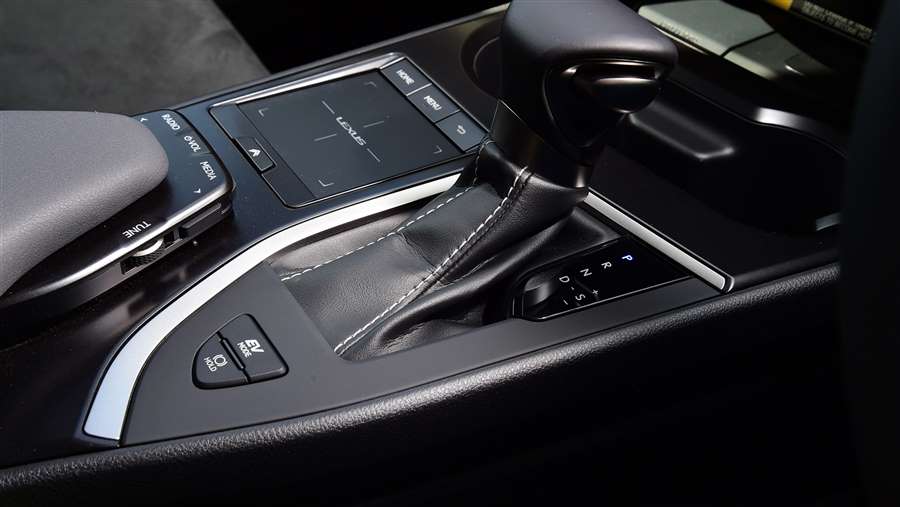
The UX model is available with a Tech & Sound Pack that equips the vehicle with the Mark Levinson audio system, head-up display, wireless charger and power-adjustable front seats and steering wheel.
The F Sport model is available with a Takumi Pack, which includes everything in the Premium Plus and Tech & Safety Packs, together with front seat ventilation, the Mark Levinson audio system, a sunroof and 360-degree camera. If you want to inject some extra flair, there's also a new ‘Cobalt’ blue trim colour for 2020, as well as an ‘F White’ colour scheme with contrasting black and white leather for the seats and dashboard.
Practicality & boot space
The Lexus UX is reasonably spacious for passengers, but boot space is tight
The restrictions enforced by the Lexus UX's compact overall dimensions presented its designers with a major challenge when it came to interior packaging, and the sleek crossover is further hamstrung by its low, curvaceous roofline. As a result, although space inside is adequate, there's no mistaking the Lexus UX for a versatile family car.
Lexus UX interior space & storage
Front-seat passengers get by far the best deal inside the UX, where the wraparound dashboard gives the driver a cocooned feeling without claustrophobia setting in. There's more headroom than you might expect, thanks largely to the low-set seats.
The same is true in the back, but the narrow windows don't let a great deal of light in. It means rear-seat passengers get the impression of there being less space than there actually is, and most will actually find knee and headroom adequate.
Boot space
With a high floor, boot space is just 320 litres - a small size for the class and 150 litres less than the BMW X2 offers. Things get even worse with four-wheel drive fitted, because the extra mechanical hardware reduces boot space to 283 litres - less than you get in a Ford Fiesta.
The rear seats fold with a 60:40 split should you need to expand the boot without passengers on board, but the steeply raked rear windscreen puts paid to the notion of carrying bulky items.
Source: carbayer.com

